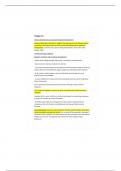Summary
Psy 1005 S - Lifespan development Summary
- Course
- Institution
- Book
This is a comprehensive and detailed summary on Chapter 13; lifespan development and social and emotional development for the book Psychology by Saundra K. Ciccarelli. Quality stuff!! U'll need it!!
[Show more]




